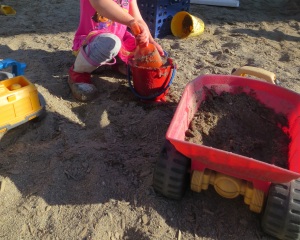As a preschool teacher for many years, I am always asked what kind of preschool program I recommend.
My short answer: “It depends.”
The program in itself should not be the deciding factor. You have the child’s interests to consider, as well as the ability of the teachers to implement the program.
 Rolling plastic eggs down a ramp
Rolling plastic eggs down a ramp
I was fortunate to participate in an intensive preschool teaching conference by Bing Institute, the preschool laboratory program of Stanford University in California.
For five days they showed through classroom observations and experiential activities, how the five basic simple materials– sand, clay, water, blocks, and paint when used consistently, could teach and engage young children.
 Scooping sand to a bucket and then transferring to a waiting dump truck
Scooping sand to a bucket and then transferring to a waiting dump truck
It was impressive how the organizers were able to tie up the use of the basic materials to the cognitive, social, emotional, and physical domains of learning.
On the last day of the conference, as the facilitators were trying to summarize 40 hours of hands on experience and presentations, the participants were asked to share what they learned.
As I was contemplating my answer to share with my peers, I had an epiphany!
- The materials are not as important as the teachers who use them. The children become successful in making connections to the real world because of the teachers.
Observational Drawing: Vegetables from the Farmer’s Market
- The teacher’s skill to facilitate learning and growth in the classroom is crucial.
Making Healthy Choices Project: Grains, Fruits, Vegetables, Protein, Dairy
Smart boards and computers are important and some say, even necessary, to stay competitive in the preschool market.
But I say, a good teacher with simple materials will always trump incompetent teachers with computers.
(Follow up blog entry: What makes a good preschool?)



